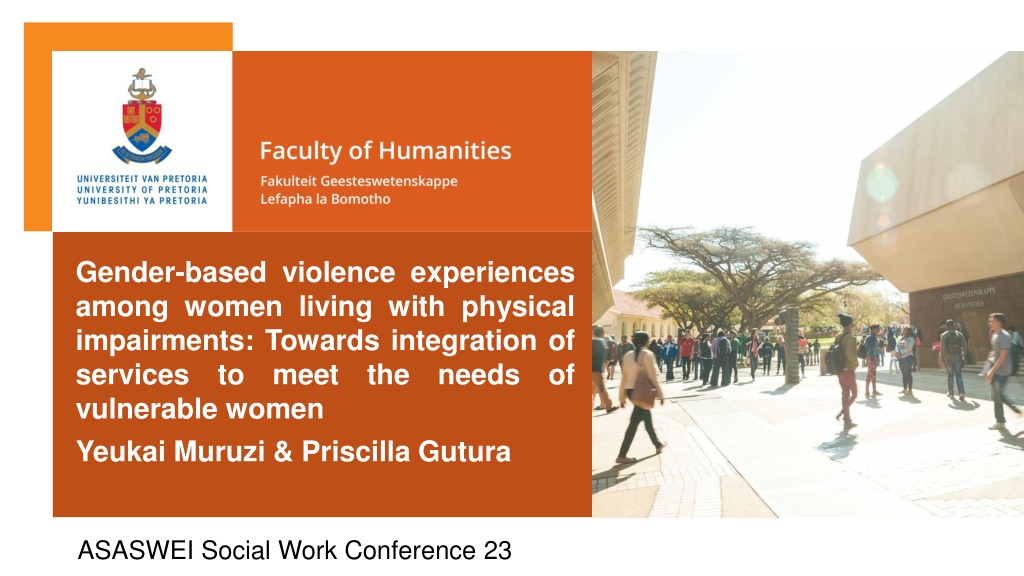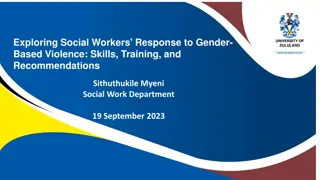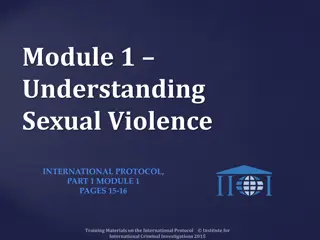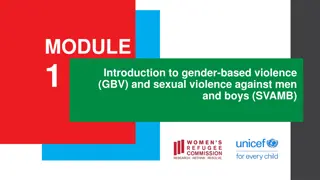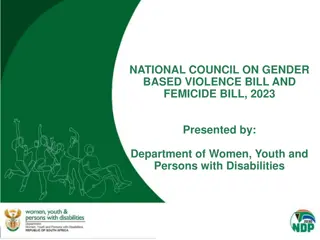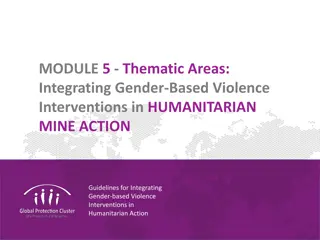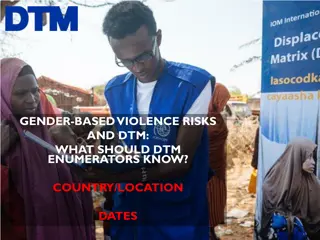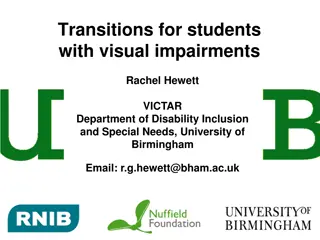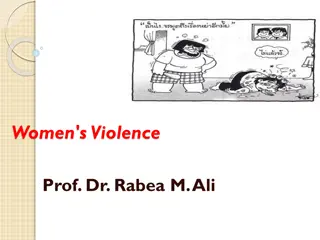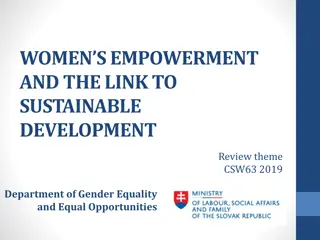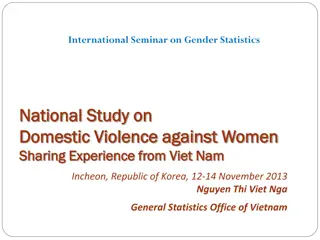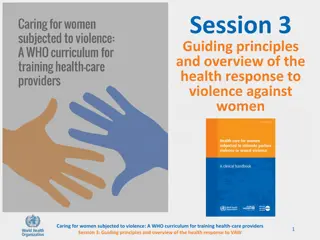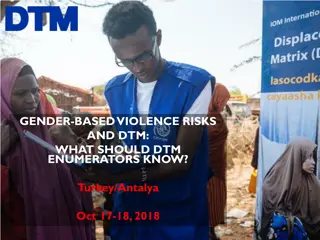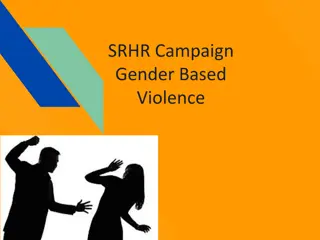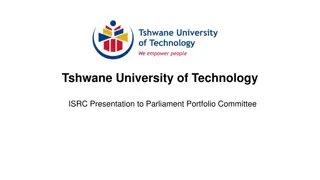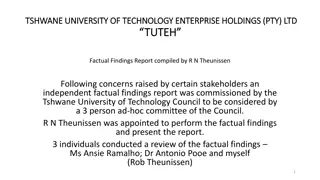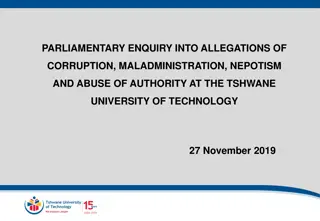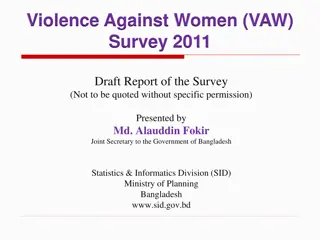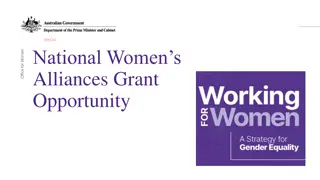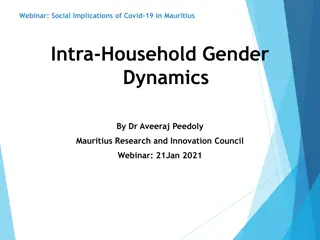Gender-based Violence Experiences Among Women with Physical Impairments in Tshwane Metro, Pretoria
This study explores the gender-based violence experiences of women with physical impairments in Tshwane Metro, Pretoria. It aims to identify risk and protective factors, recommend multi-disciplinary collaborations for GBV initiatives, and sheds light on the underrepresentation of women with disabilities in GBV research in South Africa. The research methodology involves a qualitative case study approach with purposive sampling of 12 women, focusing on thematic analysis and ethical considerations.
- Gender-based violence
- Women with disabilities
- Physical impairments
- South Africa
- Qualitative research
Download Presentation

Please find below an Image/Link to download the presentation.
The content on the website is provided AS IS for your information and personal use only. It may not be sold, licensed, or shared on other websites without obtaining consent from the author. Download presentation by click this link. If you encounter any issues during the download, it is possible that the publisher has removed the file from their server.
E N D
Presentation Transcript
Gender-based violence experiences among women living with physical impairments: Towards integration of services to meet vulnerable women the needs of Yeukai Muruzi & Priscilla Gutura ASASWEI Social Work Conference 23
Presentation layout Introduction and background Goal and objectives of the study Research methodology Study findings Conclusions Recommendations 2
Introduction and background Gender is a socially formulated role instilled through socialisation Gender inequality & conservative norms cause GBV (Graaff & Heinecken, 2017) Though a country with progressive legislation, SA is still battling GBV. Disability is a risk marker of GBV (Valentine et al., 2019) Women with disabilities are exposed to GBV, more than women without disabilities and men with disabilities There is less representation of women with physical impairments in GBV research in SA 3
Goal and objectives of the study Goal: To explore & describe gender-based violence experiences among women with physical impairments in Tshwane Metro, Pretoria Objectives: to explore forms of gender-based violence women with physical impairments experience To ascertain risk & protective factors for GBV against women with physical impairments To recommend social workers multi-disciplinary collaborations in GBV initiatives to protect women with physical impairments 4
Research methodology Research approach: qualitative Research design: case study Type of research: applied Sampling strategy: purposive sampling Sample: 12 women with physical impairments living in Tshwane Metro Data collection: semi-structured open-ended interviews Data analysis: thematic analysis Data quality: Trustworthiness Ethical considerations: informed confidentiality & anonymity, voluntary conduct the study consent, participation, permission avoidance of harm, to 5
Socio-demographic information Age Race Home language Marital status Highest qualification Employment status Type of impairment 26 Black Zulu Single Tertiary level Employed Cerebral palsy 1 22 Black Tsonga Single Grade 12 Unemployed Visually impaired Cerebral palsy 2 38 White English Single Tertiary level Employed part time 3 36 Black South Sotho Single Grade 11 & ABEIT Unemployed Visually impaired Visually impaired Paraparesis 4 33 Black Tsonga Single Grade 12 Unemployed 5 33 Black Sepedi Married Tertiary level Employed 6 35 Black Zulu Single Tertiary level Employed Cerebral palsy 7 25 Black Xhosa Single Grade 12 Unemployed Visually impaired Visually impaired Visually impaired Visually impaired Hemiplegia 8 30 Black Xhosa Single Grade 12 Unemployed 9 28 Black Sesotho Married Grade 12 Self-employed 10 22 Black Zulu Single Grade 12 Unemployed 11 33 Black Sesotho Single Grade 11 Unemployed 12 6
Study findings Theme Subtheme Forms of gender-based violence Emotional abuse, sexual, structural violence, financial and physical violence Risk factors Stereotypes impairments Non-disclosure of the experienced violence associated with physical Protective factors Seeking professional help Disclosing experienced violence Self-acceptance of one s condition 7
Theme 1: Forms of gender-based violence Emotional abuse 11 participants were exposed to emotional abuse 4 experienced emotional violence linked to disability stigma & 7 experienced emotional related disturbance emanating from other forms of abuse One participant experienced emotional related disturbance due to sexual abuse: I was very scared, emotionally I was always alert because even if I talk about it, I had nothing to prove because I was not raped (sexual assault). So I felt helpless as well, like there was no hope. I felt like I was not enjoying my childhood the way I was supposed to. Everything was just I was just deeply scarred. It was all emotional (participant 8, with visual impairment). 8
Theme 1: Forms of gender-based violence Sexual violence Eight participants experienced sexual violence. Five sexually assaulted and three raped I have experienced sexual assault or usually people would refer to it as rape. I think twice, yes twice. The first was through a friend I knew and the second was through someone I couldn t identify because of my disability of course (participant 11, with visual impairment). I think I was about eight or nine years, I was raped by a brother who is my aunt s child. So he was like a brother to me. The family never spoke anything about it, like nothing ever happened but then that still lives with me you know. But now it comes to how do my own mother like a person who is supposed to protect me let things like that slide? (participant 6, with paraparesis) 9
Theme 1: Forms of gender-based violence Financial abuse Six participants were exposed to financial abuse Through misuse of the grant money, over reliance of family on the grant and asking for help to transfer money in public places I have had an incident where I asked someone to help me to transfer some money. So, what they did is they would first transfer to themselves and then do the actual transfer I have asked. Leave the second sms after they have taken their own. Our lives are very expensive (participant 5, with visual impairment). The expectation at home is that I contribute towards household needs. I never thought of it as financial abuse before. But now I can t necessarily do everything that I wish to do like on a personal level. Even if there an advert for a job or any opportunity, I can t try it because I need to first think of the needs of the house before I look at my own needs (participant 2, with visual impairment) 10
Theme 1: Forms gender-based of violence Structural violence 9 participants experienced structural violence in the school environment, health care facilities and workplace. I got a job on gumtree and called for the interview and got the job. It was a very small admin job, I already had a degree and everything. I think they were paying four or five thousand Rand. So I asked why they wanted a 86 person with a disability and he answered and said, Well, because we can pay them less. (participant 3, with cerebral palsy). I applied for employment at my current employer. I passed the interview and then after that, it was my first day at work. The supervisor who was supposed to be my supervisor at that moment was not aware of my disability. So when she first saw me, she was angry because in her mind I could not perform the duties because of my disability (participant 7, with cerebral palsy). 11
Theme 1: Forms gender-based of violence Physical abuse Three participants experienced physical abuse. One as an adult and the other two during childhood. After my mother passed on, my maternal aunt started living with me. She physically abused me, beating me. The process it would obviously leave me wounded because she would hit me in places where no one would see the wounds or the bruises (participant 8, with visual impairment). 12
Theme 2: Risk factors associated with experiencing gender-based violence Stereotypes associated with physical impairments Assumptions, labels and discriminatory practices that risk gender- based violence victimisation. physical impairments are assumed to mean mental illness: One participant mentioned how For me one of the biggest thing people often think when you have a physical disability is you are also impacted in a mental way. People with physical disabilities doesn t necessarily mean mental disability. It s a wrong assumption, people with disabilities are still people. You got to put the person first, look at a person holistically (participant 3, with cerebral palsy). 13
Theme 2: Risk factors associated with experiencing gender-based violence Non disclosure of the violence experienced Non-disclosure can result in perpetuation of victimisation. So, when it happened (sexual assault) I spoke to my aunt the next day when she came back. She said I mustn t say anything to anyone about it and days went on. Academically as well at school I started slowing down. He didn t stop by then, he kept on doing it for days and weeks, it lasted. Up until I lashed out and broke down at school, attempting to commit suicide (participant 8, with visual impairment). 14
Theme 3: Protective factors Protective factors can enable prevention of further victimisation and promote coping. Obtaining professional help The teachers became aware of the situation (repeat sexual assault). They called aunt in and spoke to her about it and they took the case to the police station. So, I started feeling like it was not my fault because all along I kept on blaming myself thinking it s my fault (participant 8, with visual impairment). 15
Theme 3: Protective factors Disclosing violence experienced Luckily for me I spoke to my supervisor and they took the matter up because it was starting to bother me. Whenever he could come in the office if I am alone, he would try to kiss me and so forth. So I handled the situation very well and early. I reported him and then it stopped there (participant 7, with cerebral palsy). Self acceptance of one s condition I think the first one is the attitude you carry yourself with. If you carry yourself with an attitude of I am confident and I am not passive, I am more of an assertive person. That already scares away a lot of people from mistreating you (participant 10, with visual impairment). 16
Conclusions Gender based violence among women with physical impairments is an existing reality They suffer double risk of gender based violence due to gender and disability Thus making them more vulnerable to severe forms of GBV There are risk factors that increase the likelihood of violence However, protective factors prevent further victimisation & promotes coping Protective factors can influence development of strategic responses or measures to address GBV among this cohort 17
Recommendations GBV multi-sectorial response strategies ought to be inclusive of women with physical impairments Increased representation in GBV research and policies Social work family assessments and education Public education that challenge and demystify stereotypes associated with gender and disabilities. 18
THE END Thank you for your attention
